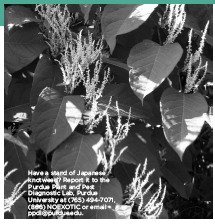
Spring 2008
volume 17 No. 1
A Knotty Problem
Japanese knotweed ( Fallopia japonica) is an invasive plant from Japan that was introduced around the world for use in landscaping. By 1894, it was reported as naturalized on sites in Pennsylvania, New York and New Jersey. Despite these early warning signs, by 1910 it was being described in garden catalogs in the U.S. By 1938, information was already being published on how to get rid of the plant in gardens.

Japanese knotweed now covers thousands of acres of riparian area on the East and West Coast of the U.S. and is making significant inroads into the Midwest. In Indiana, there are naturalized populations in almost every county, but most infestations are relatively small. Japanese knotweed is a huge plant, growing rapidly each spring to a multi-stemmed, shrubby plant 5-10 feet tall, only to be cut down by the first winter frost and grow afresh the next spring. Leaves are about six inches long and three-to-four inches wide, broadly oval to triangular, and alternate on the stem. Small greenish-white flowers are produced in axillary sprays in mid-summer. It forms rhizomes which can reach 45-to-60 feet in length and have enough power to send sprouts through asphalt.
It is actually a dioecious plant, which means that you need male and female plants for sexual reproduction to occur. Seed production is very rare (perhaps unknown) in North America so this species has achieved its wide distribution solely by vegetative reproduction, forming dense clonal thickets. Growing along creeks and rivers, these tall thickets displace other plants and therefore eliminate the fibrous network of roots that hold the creek bank together. This can lead to bank shear during flood times, dumping sediment and rhizome fragments into the creek to be carried downstream and start new populations of knotweed.
Once established, Japanese knotweed is very difficult to eradicate. Cutting the stems several times per year for multiple years can exhaust the plantís root resources and eventually diminish the stand. For quicker and more effective control, cut stems can be painted with a 30-50 percent triclopyr or glyphosate product that is labeled for aquatic sites. Cut stems that have nodal buds can sprout if they have contact with moist soil; it is important to dispose of the cut stems appropriately. Remove them from the floodplain or hang them in trees (high enough so flood events wonít dislodge them) to dry. Foliar treatments are generally considered a more effective control method; 3-5 percent triclopyr or glyphosate product that is labeled for aquatic sites should be applied from June to September. Re-treatment will likely be necessary. n